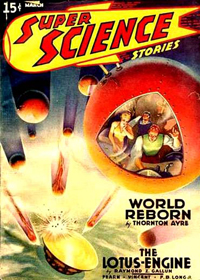
Super Science Stories was an American pulp science fiction magazine published by Popular Publications from 1940 to 1943, and again from 1949 to 1951. Popular launched it under their Fictioneers imprint, which they used for magazines, paying writers less than one cent per word. Frederik Pohl was hired in late 1939, at 19 years old, to edit the magazine; he also edited Astonishing Stories, a companion science fiction publication. Pohl left in mid-1941 and Super Science Stories was given to Alden H. Norton to edit; a few months later Norton rehired Pohl as an assistant. Popular gave Pohl a very low budget, so most manuscripts submitted to Super Science Stories had already been rejected by the higher-paying magazines. This made it difficult to acquire good fiction, but Pohl was able to acquire stories for the early issues from the Futurians, a group of young science fiction fans and aspiring writers.
Super Science Stories was an initial success, and within a year Popular increased Pohl's budget slightly, allowing him to pay a bonus rate on occasion. Pohl wrote many stories himself, to fill the magazine and to augment his salary. He managed to obtain stories by writers who subsequently became very well known, such as Isaac Asimov and Robert Heinlein. After Pohl entered the army in early 1943, wartime paper shortages led Popular to cease publication of Super Science Stories. The final issue of the first run was dated May of that year. In 1949 the title was revived with Ejler Jakobsson as editor; this version, which included many reprinted stories, lasted almost three years, with the last issue dated August 1951. A Canadian reprint edition of the first run included material from both Super Science Stories and Astonishing Stories; it was unusual in that it published some original fiction rather than just reprints. There were also Canadian and British reprint editions of the second incarnation of the magazine.
The magazine was never regarded as one of the leading titles of the genre, but has received qualified praise from science fiction critics and historians. Science fiction historian Raymond Thompson describes it as "one of the most interesting magazines to appear during the 1940s", despite the variable quality of the stories.[1] Critics Brian Stableford and Peter Nicholls comment that the magazine "had a greater importance to the history of sf than the quality of its stories would suggest; it was an important training ground".[2]
- ^ Cite error: The named reference
SFFWFM_SSSwas invoked but never defined (see the help page). - ^ Brian Stableford & Peter Nicholls, "Super Science Stories", in Clute & Nicholls, Encyclopedia of Science Fiction, p. 1187.